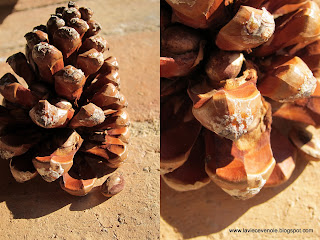This time, I avoided all the highways. It took most of the day to get there, but it was magical. We went through the tiniest Provencal villages, through big cities (Nimes and Marseille), and above all through the rolling, endlessly changing countryside.
The fruit and vegetable stands, with their hand-lettered signs, were up and running nearly everywhere. The cigales were screeching away; we knew this because the top stayed down the entire trip.
We stopped for lunch and a wander in Salon-de-Provence, made memorable by its remarkable fontaine moussue.
The fountain dates from the sixteenth century, and the lime deposits from the water have made over time a natural sculpture covered in moss and fairy-light, fern-like vegetation. Underneath the mushroom-shaped limestone, water drips constantly. It is hypnotic, a cave in the making, in the bright light of day.
The animation of the cities has become a bit unfamiliar and exciting for us, so it was also a pleasure to drive through them. But I had a specific idea in mind: I was willing to risk hitting Friday evening rush hour in Marseille for the sake of D559. Also known as La route de la Gineste, D559 runs from Marseille to Cassis, above the deep, rocky coastal inlets, and across the windswept limestone clifftops and plateau. It is not to be missed.

See the tiny houses in that valley? Breath-taking terrain, every inch of the way, and then, after the nth hairpin turn, Cassis and its golden rockface swerve into view.
This was the view from our room, taken by my five year old while I was having a well-earned shower.I have written about Cassis before, here and here and here, so the basics about this charmingly low-key port have been covered. But there are always lovely spots in Cassis to admire--and photograph.
To better see some of the detail of this gorgeous Ferris Wheel, you can click on the image. My son's in the St. Exupery/Le Petit Prince airplane...
In the center of the photo below, two men are sea jousting (you might have to click on the image again to better see). Each standing on a fast-moving boat, the opponents are trying to knock one another into the cold water using lances. Sea jousting dates from Ancient Greece and Rome, and has been played in port and river towns across France since the time of the Romans. Provencal sea jousting (joute nautique) is considered the most aggressive of the various versions. These days, even women have begun to joust, according to the national federation.
I watched from the balcony, and decided I'd rather stroll around looking at boats rather than falling off them.
Once back from Cassis, my kids spent the day at our neighbor's place. Building a hut in their dry riverbed was the main order of the day, but the children also collected pinecones. Arriving on the tail end of their foraging session, I was able to grab a couple of cones.
These cones are from a very large, mature umbrella pine, and you can see the seed pods are tucked back in between the scales. While this wasn't the greatest year for pine nuts, there is still nothing finer than to dislodge the seed pods, and, using a small stone, crack open the seed pods and eat the creamy colored pine nut within. Fresh pine nuts have a slightly resinous, almost eucalyptic flavor, far more intense than anything found in a store. They taste simply spectacular, which perhaps explains why I have never been able to get anyone to collect them for anything other than their own immediate consumption. If you are lucky enough to get your hands on some fresh pine nuts, or you choose to go the storebought route, I have just the recipe. I found it in Real Simple magazine years ago, a simple riff on Italian biscotti ai pinoli, which I slightly tweaked; it is devoured by kids and adults alike. I haven't made it lately (hence the lack of a photo). Let me know what you think. I'd love to post a photo of your cookies, so do send me one if you try the recipe.
Biscuits au pin de pignon (Pine Nut Drops)
2 sticks unsalted butter, at room temperature
1 cup packed dark brown sugar
1/2 cup granulated sugar
2 tablespoons agave or corn syrup
1 teaspoon vanilla extract
1 large egg
2 3/4 cups all-purpose flour
1 1/4 teaspoons baking soda
3/4 teaspoon salt
1/2 teaspoon ground cardamom
1/4 teaspoon ground nutmeg
2 1/2 cups raw pine nuts
Preheat oven 190C/375F. Line two baking sheets with parchment paper. Beat the butter, brown and granulated sugars, corn syrup, and vanilla for two minutes using an electric mixer. Add egg and beat until combined. In a separate bowl, whisk together the flour, salt, baking soda and spices. Reduce mixer speed to low and gradually add the flour mixture to the egg mixture.
Shape the dough into tablespoon-size balls. Spread the pine nuts in a low dish. Roll each ball in the pine nuts, pressing so the nuts adhere. Place the balls two inches apart on the prepared baking sheets. Bake until just lightly browned at the edges, about 12 minutes. Cool on the baking sheets for five minutes. Transfer the cookies to wire racks and cool completely.












